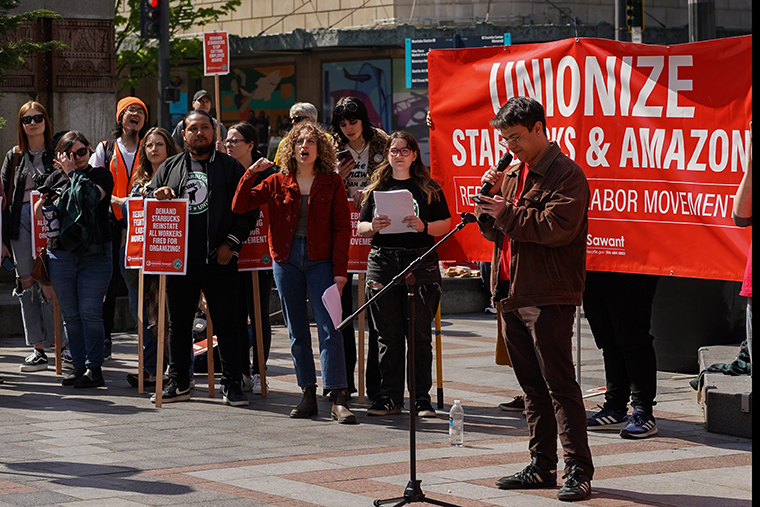Increasingly, the American dream is out of reach for many Americans. The chance that a U.S. worker does better economically than her parents remains low compared with peer nations, especially among children born to low-income families. But why? And how can U.S. workers reclaim their power and achieve economic stability and long-term success?
Stalled economic mobility, particularly among low-wage workers, and a decline in worker power over the last several decades are the focus of a new landscape report conducted by Jake Rosenfeld, a professor of sociology in Arts & Sciences at Washington University in St. Louis, and Ioana Marinescu, an associate professor at the University of Pennsylvania School of Social Policy and Practice. (Marinescu is currently on leave to serve as principal economist in the antitrust division at the U.S. Department of Justice.)

“The ongoing pandemic has underscored that certain groups of workers bear the brunt of maintaining vital services and providing essential goods, yet they have limited decision-making authority over their working conditions and are often underpaid,” said Rosenfeld, author of “What Unions No Longer Do” and “You’re Paid What You’re Worth and Other Myths of the Modern Economy.”
“Our country is at an inflection point. The choices we make now will influence the path of worker power and economic mobility. Through informed policy choices, we can empower workers in the decades to come and ensure the American dream remains relevant for future generations.”
In the report, Rosenfeld and Marinescu outlined recommendations for designing effective programs, policies and practices to rebalance the economic playing field for workers. They also identified areas in which further research is needed to understand the ramifications of potential policy decisions.
The report is part of a series commissioned by WorkRise, a research-to-action network on jobs, workers and mobility based at the Urban Institute. The Bill and Melinda Gates Foundation, the Mastercard Centers for Inclusive Growth and others funded the research.
Policies that increase worker power
Worker power — employees’ ability to demand better wages and working conditions — is affected by two factors: employees’ bargaining power with the organization (voice) and opportunities outside of the organization (exit).
‘Through informed policy choices, we can empower workers in the decades to come and ensure the American dream remains relevant for future generations.’
Jake Rosenfeld
Indicators of worker power — such as wage levels for workers without a college degree, union membership rates or nonmanagerial workers’ total share of income — reveal a steep decline from the late 1970s onward, the authors said.
Rosenfeld and Marinescu said the following policies can increase worker power by increasing exit options for workers:
- Increase the minimum wage. According to the authors, increasing the minimum wage prevents employers from exploiting the lowest-paid workers, does not lead to employment losses — if minimum wages are not too high — and helps address the racial gap in worker power.
- Strengthen labor antitrust enforcement. Mergers not only decrease product competition, but they also decrease opportunities in the labor market leading to lower wages, the authors explained. The 2021 Executive Order on Promoting Competing in the American Economy advocates such an approach.
- Limit noncompetition agreements, which are common in many occupations, to increase workers’ choice among employers, resulting in higher wages.
- Expand national professional licensing. State-specific licenses make it more difficult and costly for workers to move for better job opportunities. However, this is a double-edge sword, as professional licenses have been shown to benefit people of color, enabling them to demonstrate qualifications and earn higher wages.
- Institute pay transparency laws. Employers will always have more information available to them regarding wages, but there are ways to shift the information asymmetry. Pay transparency laws empower employees by giving them access to information about salaries within the organization, thereby strengthening their negotiating power. Likewise, banning employers from soliciting workers’ wage history can empower workers.
These labor laws are one avenue for increasing American workers’ power. According to Rosenfeld and Marinescu, policies that enable workers’ ability to say no to bad jobs and choose their best job match are another avenue to consider. Such policies come in many forms. For example, by severing the link between employment and health insurance, public health insurance programs like Medicaid and Medicare can strengthen a worker’s outside options for employment.
Racial discrimination in the labor market
Racial discrimination in the labor market further impedes minority workers’ ability to move up the economic ladder. Surprisingly, though, Rosenfeld and Marinescu reported that most anti-discrimination policies proposed to address this discrimination do not increase minority worker power.
“Limiting background checks or drug tests are examples of policies that are meant to help minority workers. But without this screening information, research finds that employers are more likely to let their biases dictate hiring decisions,” the authors said.
“Drug testing increases Black employment by 7% to 30% and relative wages by 1.4% to 13%. As long as employers hold negative beliefs about Black workers — regardless of their accuracy — preventing employers from accessing criminal background, credit history or drug use can backfire.”
Declining union rates
According to Rosenfeld and Marinescu, deunionization has played a significant role in stalling mobility for low-wage workers both within and across generations. In the U.S., only about one in 17 private sector workers belong to a union (6.1%). By comparison, over a third of the public sector remains unionized (33.9% as of 2021).
While it’s true that globalization and changes in technological changes have hurt unions in the U.S. and other developed economies, Rosenfeld said that does not fully explain why union rates have fallenl so dramatically here.
“Employer resistance to unions began in the 1960s and accelerated through the 1970s and 1980s. Today, companies pay anti-union consultants and specialty law firms, on average, $340 million every year to fight unionization efforts. That’s a big hurdle for employees to overcome,” Rosenfeld said.
Today’s tight labor market has renewed interest in unionization, though, and for good reason: Policies that would promote unionization would reduce inequality, lower poverty and create greater intergenerational mobility, Rosenfeld said.
“No other single intervention on behalf of workers has the direct and indirect influence on worker power and mobility within workplaces that labor unions have had,” the authors wrote.
The PRO Act, which the House of Representatives passed in 2021 and awaits action in the Senate, would be the most significant piece of pro-labor legislation enacted since the National Labor Relations Act in 1935. Among other things, the reform includes a crackdown on employer retaliation in union elections and bans common practices such as mandatory-attendance meetings, during which employers warn workers of the consequences of unionization.
Another way to increase worker voice within organizations is to mandate worker representation on corporate boards, a common policy in other political economies, Rosenfeld said.
The most important message, according to Rosenfeld and Marinescu, is that change is possible.
“The landscape report provides researchers, policymakers and others with a blueprint to assess these solutions and move forward so that the American dream remains within research for all workers,” he said.



